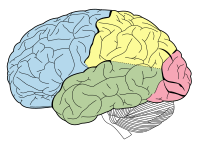
Photo from wikipedia
Forming a memory often entails the association of recent experience with present events. This recent experience is usually an information-rich and dynamic representation of the world around us. We here… Click to show full abstract
Forming a memory often entails the association of recent experience with present events. This recent experience is usually an information-rich and dynamic representation of the world around us. We here show that associating a static cue with a previously shown dynamic stimulus yields a detectable, dynamic representation of this stimulus. We further implicate this representation in the decrease of low-frequency power (∼4–30 Hz) in the ongoing EEG, which is a well-known correlate of successful memory formation. The reappearance of content-specific patterns in desynchronizing brain oscillations was observed in two sensory domains, that is, in a visual condition and in an auditory condition. Together with previous results, these data suggest a mechanism that generalizes across domains and processes, in which the decrease in oscillatory power allows for the dynamic representation of information in ongoing brain oscillations.
Journal Title: Journal of Cognitive Neuroscience
Year Published: 2018
Link to full text (if available)
Share on Social Media: Sign Up to like & get
recommendations!